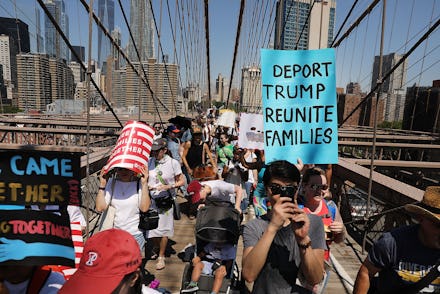Steep obstacles loom as second deadline to reunite immigrant families nears

The second court-ordered deadline for the Trump administration to reunite separated immigrant families is on Thursday, but it appears that officials are set to allow it to blow past without ensuring full reunification for hundreds of children with their parents.
When U.S. District Judge Dana Sabraw ordered the Trump administration to immediately halt its policy of separating immigrant children from their parents in June, he also imposed two deadlines for reuniting the splintered families. The second deadline is July 26 — but according to the government’s own recently released data, more than 1,300 children still have yet to be reunified.
In court documents filed jointly with the American Civil Liberties Union on Monday, which filed the initial lawsuit, the Trump administration claimed that it had already “appropriately discharged” 1,187 of the 2,551 children ages 5 and older who were due to be reunited with their parents, in compliance with the court order. According to the filings, an additional 447 children are eligible for reunification, but haven’t completed the process yet, for one reason or another.
In the same federal filing, the government also noted that an additional 917 parents are either not eligible for reunification or “not yet known to be eligible.” Of that group, 463 could be ineligible because they “may no longer be in the United States” — making it seem more than likely that the government will fall far short of meeting the court’s deadline by Thursday. (In the July 23 court filings, the government noted that those cases are currently “under review.”)
This isn’t the first time the government has been unable to comply with a court-ordered deadline to reunite the immigrant children it separated since May 7, when Attorney General Jeff Sessions announced that the U.S. would begin separating families at the border as part of a Trump-sanctioned zero tolerance crackdown on immigration. On July 10, the government announced that it had successfully completed the reunification of 58 out of 103 of the separated children under the age of five, which Sabraw had ordered reunited with their parents by that date. Explanations for why nearly half of that group had been deemed ineligible ranged widely, from “safety concerns posed by the adults in question” to the fact that those parents or guardians “may no longer be in the United States.”
In Monday’s court filing, the government provided a similar list of circumstances that could potentially render a parent and child ineligible for reunification, including the government being unable to locate the parents in question, and parents that have an alleged criminal history that could endanger the child.
However, even if a parent is deemed eligible for reunification with their child, the question of whether or not they will receive asylum in the U.S. is an entirely separate matter.
Immigration attorneys and legal aid workers have long warned that without adequate access to legal counsel while being held in detention, immigrant parents are more likely to make uninformed decisions or abandon their asylum claims entirely because they believe it will allow them to be reunited with their children more quickly.
This set of circumstances led Sabraw to temporarily rule in favor of a request by the ACLU on July 16 that parents not be deported immediately after being reunited with their child. That court order, which remains in effect until July 24, ostensibly grants parents the chance to make an “informed and noncoerced” decision on whether or not to leave their minor children in the U.S. to pursue their own asylum claims.